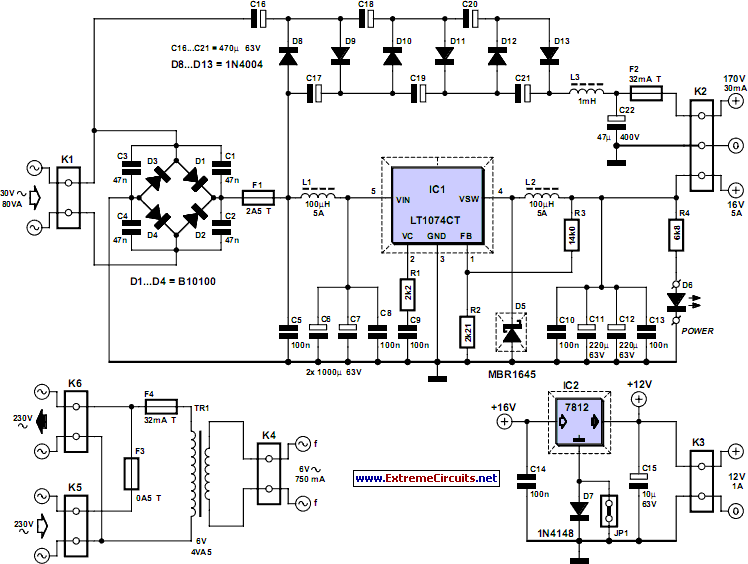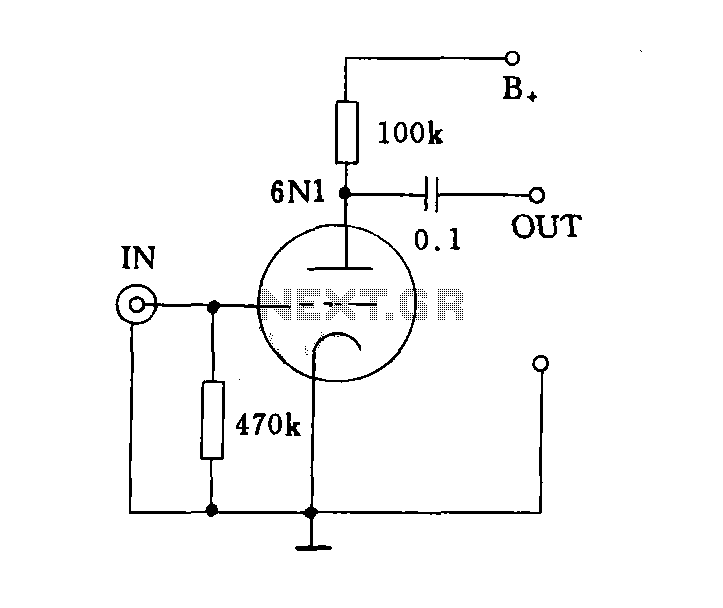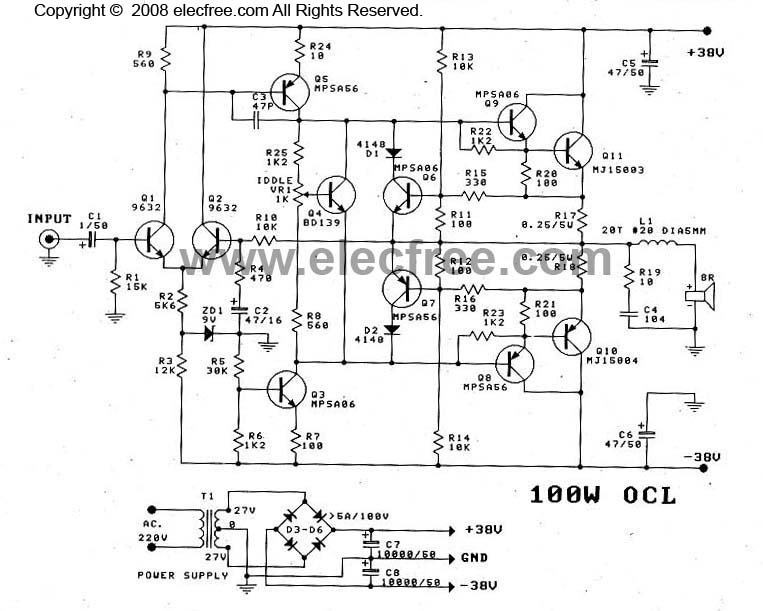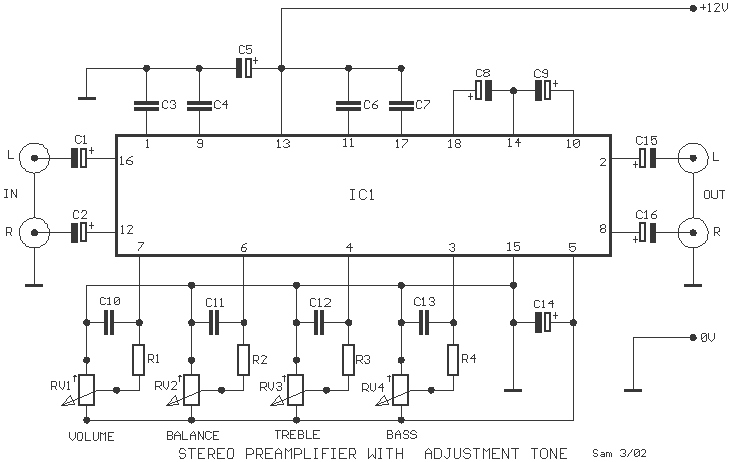
Single-ended four-channel amplifier schematic
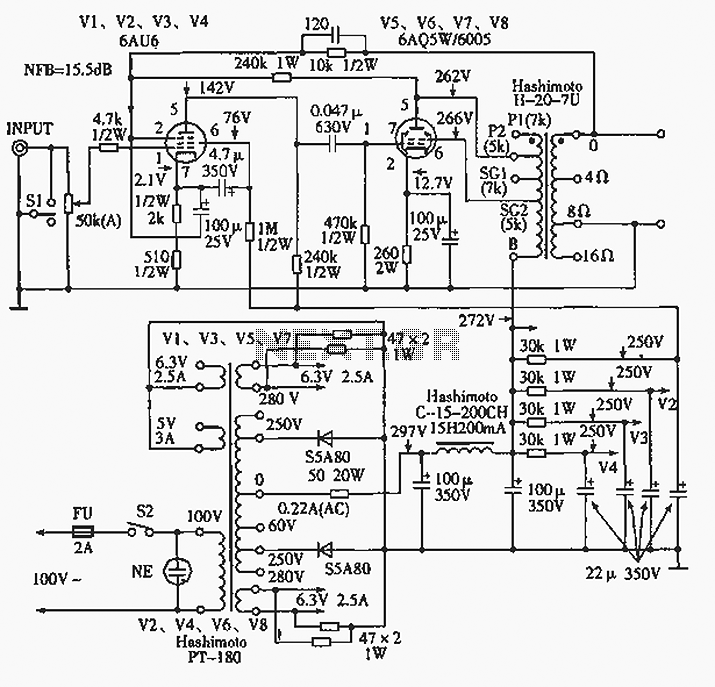
The 6AQ5W / 6005UL four-channel single-ended amplifier circuit is illustrated in the accompanying figure. Only two channels are shown, but it is part of a four-channel system that employs a power transformer for the voltage amplification section. This section utilizes the Tokyo Light Sound 4CP-2508-SA type 4, which includes a volume potentiometer for adjusting the volume across all four channels. The output stage features a UL type circuit that provides an excellent auditory experience. The negative feedback (NFB) loop has two paths: one path runs from the cathode of the tube screen output electrode through a 240kΩ resistor to the primary tube, providing a feedback amount of 6dB. The second path is taken from the output of the transformer secondary, yielding a feedback amount of 9.5dB.
The 6AQ5W / 6005UL four-channel single-ended amplifier circuit is designed for high-fidelity audio applications, leveraging the characteristics of the 6AQ5W and 6005UL vacuum tubes to deliver rich sound quality. The circuit employs a power transformer, specifically the Tokyo Light Sound 4CP-2508-SA type 4, which is essential for stepping up the voltage during amplification. This transformer is integrated into the voltage amplification section and is crucial for achieving the desired output levels.
The volume control is facilitated by a potentiometer that adjusts the signal level across all four channels uniformly, allowing for balanced audio output. This feature is particularly beneficial in multi-channel audio systems where consistent volume levels are required across different channels.
The output stage utilizes a UL (Ultra Linear) type configuration, which enhances the amplifier's performance by improving linearity and reducing distortion. The auditory output is further refined through a dual-path negative feedback loop. The first feedback path, which incorporates a 240kΩ resistor, connects from the cathode of the tube screen output electrode back to the primary tube. This configuration introduces a feedback amount of 6dB, which helps stabilize the amplifier's gain and improve overall sound quality.
The second feedback path is derived from the output of the transformer secondary. This path provides a higher feedback amount of 9.5dB, which further contributes to the amplifier's performance by reducing distortion and enhancing frequency response. The combination of these feedback paths allows for a well-rounded audio output, making the 6AQ5W / 6005UL amplifier suitable for various audio applications where clarity and fidelity are paramount.
Overall, this circuit design exemplifies the balance between performance and functionality, making it an excellent choice for audiophiles seeking a high-quality amplification solution.6AQ5W / 6005UL four-channel single-ended amplifier circuit shown in FIG. Shown are only - channels. 4-channel system - using a power transformer for voltage amplification section uses Tokyo light sound 4CP-2508-SA type 4 with volume potentiometer while adjusting the 4 channel volume. The output stage has a good sense of hearing UL type circuit. NFB loop two routes, all the way from the cathode tube screen output electrode via 240kQ resistance to the primary tube, the amount of feedback is 6dB, another way is taken from the output of the transformer secondary 81 "1, the amount of feedback is 9.5dB.
The 6AQ5W / 6005UL four-channel single-ended amplifier circuit is designed for high-fidelity audio applications, leveraging the characteristics of the 6AQ5W and 6005UL vacuum tubes to deliver rich sound quality. The circuit employs a power transformer, specifically the Tokyo Light Sound 4CP-2508-SA type 4, which is essential for stepping up the voltage during amplification. This transformer is integrated into the voltage amplification section and is crucial for achieving the desired output levels.
The volume control is facilitated by a potentiometer that adjusts the signal level across all four channels uniformly, allowing for balanced audio output. This feature is particularly beneficial in multi-channel audio systems where consistent volume levels are required across different channels.
The output stage utilizes a UL (Ultra Linear) type configuration, which enhances the amplifier's performance by improving linearity and reducing distortion. The auditory output is further refined through a dual-path negative feedback loop. The first feedback path, which incorporates a 240kΩ resistor, connects from the cathode of the tube screen output electrode back to the primary tube. This configuration introduces a feedback amount of 6dB, which helps stabilize the amplifier's gain and improve overall sound quality.
The second feedback path is derived from the output of the transformer secondary. This path provides a higher feedback amount of 9.5dB, which further contributes to the amplifier's performance by reducing distortion and enhancing frequency response. The combination of these feedback paths allows for a well-rounded audio output, making the 6AQ5W / 6005UL amplifier suitable for various audio applications where clarity and fidelity are paramount.
Overall, this circuit design exemplifies the balance between performance and functionality, making it an excellent choice for audiophiles seeking a high-quality amplification solution.6AQ5W / 6005UL four-channel single-ended amplifier circuit shown in FIG. Shown are only - channels. 4-channel system - using a power transformer for voltage amplification section uses Tokyo light sound 4CP-2508-SA type 4 with volume potentiometer while adjusting the 4 channel volume. The output stage has a good sense of hearing UL type circuit. NFB loop two routes, all the way from the cathode tube screen output electrode via 240kQ resistance to the primary tube, the amount of feedback is 6dB, another way is taken from the output of the transformer secondary 81 "1, the amount of feedback is 9.5dB.

